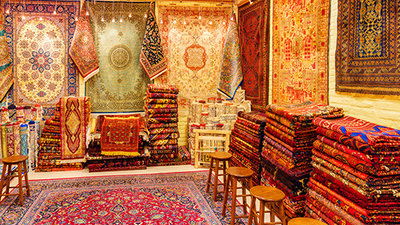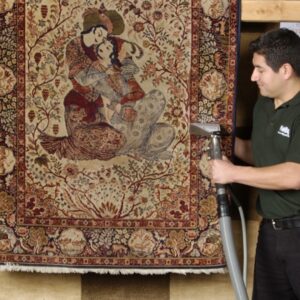Does this sound familiar? “I want to tear out my carpet and expose the beautiful hardwood floors, but I don’t want to walk around on hard, cold floors. What do I do?” Well, look no further! Rugs are an easy way to add textures, patterns, and colors to any room in your house. Let’s talk about the various types of materials used to make rugs and some basic maintenance for each.
Wool is one of the most common rug materials, and for good reason.
Its soft texture makes it the perfect complement to your smooth wood or tile floors. Wool rugs are durable and traditionally handwoven. They shed a lot during the first few months, so it is important to vacuum them frequently during that time. This shedding is normal and usually mellows out after a few months. Still, regular vacuuming is the best way to maintain your wool rug’s beautiful pattern (Leverette, 2019). You should get your rug professionally cleaned every 1-2 years in order to maintain its luster, but should take it in immediately if you have a deep set stain. Fun fact: Wool from Merino sheep, in New Zealand and Australia, is considered the highest quality for rug-making because of its softness (Amirkhan & Groseclose, 2010).

Silk is a unique material that has been used for a variety of purposes in the textile industry, including rugs.
It has a surprisingly high tensile strength, meaning the fibers won’t break when you stretch it. However, it is still vulnerable to abrasions, and thus should be placed only in low foot-traffic areas. In fact, some people suggest using silk rugs as wall decor in order to make them last as long as possible (Shadkam, n.d.)! Because silk rugs are delicate, it is important to be delicate while vacuuming and to take them to a professional cleaner every 2 to 3 years to prevent any dirt buildup. Fun fact: Silk is said to have been discovered by a Chinese empress who accidentally dropped a silkworm cocoon into her cup of tea. According to legend, the cocoon unraveled to reveal a single thread and thus came silk (Amirkhan & Groseclose, 2010)!
Cotton is another material used for rugs.
Cotton is less expensive than wool or silk, so these rugs are considerably more affordable. Cotton is durable and easy to clean, especially since many cotton rugs are machine washable. However, it is still vulnerable to sun damage, so be sure to keep it out of direct sunlight. Although cotton rugs are more durable than silk and wool, you should still get them professionally cleaned every 2 to 3 years. The professional cleaners will fully wash the rug and remove dirt embedded in the fibers, as these can wear down the rug. Fun fact: Scientists are in the process of genetically engineering cotton to naturally produce different colors (purple, black, etc.). This would make colored cotton rugs more eco-friendly, as the dyeing process for rugs can be harmful depending on the type of dye companies use (Segran, 2020).

Lastly, rugs are being increasingly made of synthetic materials.
These include nylon, polypropylene, and polyester (Amirkhan & Groseclose, 2010). Synthetic fibers are generally resistant to sun damage and mildew/mold, but they are more prone to getting stains, especially oil-based stains (Colley, 2010). These rugs are generally easy to clean, but you should take care while vacuuming so you don’t break the fibers. It is still recommended that you get these professionally cleaned, as they are particularly vulnerable to breakage from harsh scrubbing. Synthetic rugs don’t hide dirt very well, so it is good to get them cleaned every year. Fun fact: Since synthetic fibers are inexpensive compared to other materials, rug makers are using synthetic materials to make affordable rugs with oriental designs (Amirkhan & Groseclose, 2010).
Kelly Cleaning uses state of the art technology to clean all types of rugs.
We use a variety of cleaning methods for your delicate rugs, never chemical washes. In fact, soon, Kelly Cleaning is opening a new rug cleaning plant: the Kelly Ultimate Rug Spa. You can be sure that your rugs will receive the utmost care and attention to clean, restore, and brighten them at the Kelly Ultimate Rug Spa.
References
Amirkhan, E., & Groseclose, A. (2010). A Comprehensive Guide to Oriental & Specialty Rug Cleaning (2nd ed.). Master Rug Cleaner, LLC.
Colley, A. S. (2010). Natural Vs. Synthetic Rugs, What are the PROs and CONs. A C Styles Designs, LLC. https://acstylesdesigns.com/about/articles/item/21-natural-vs-synthetic-rugs-what-are-the-pros-and-cons
Leverette, M. M. (2019). How to Clean a Wool Rug. The Spruce. https://www.thespruce.com/how-to-clean-a-wool-rug-4177780
Segran, E. (2020). Scientists are growing psychedelic cotton in the lab. Fast Company. https://www.fastcompany.com/90536103/scientists-are-growing-psychedelic-cotton-in-the-lab
Shadkam, R. (n.d.) Silk Rugs Vs. Wool Rugs. Catalina Rug. https://www.catalinarug.com/blog/silk-rugs-vs-wool-rugs/




